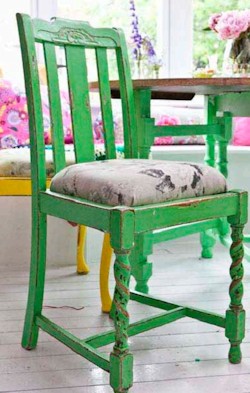Doing up old, secondhand furniture is a must to achieve the vintage look in your home, whatever era you are going for. One of the best ways to completely transform an old piece is by painting and distressing it. Simon Bell, who owns a secondhand furniture shop in West London, specialises in this technique, and he shared his secrets with me when I did up a chair at my Vintage Café. It really is an easy and straightforward technique and has amazing results. What was a dull old chair became a bright and wonderful piece of furniture.
To make it work effectively with your chosen vintage era, do your research and choose a colour that was typical of the time, or take inspiration from a vintage fabric.
You will need:
- Dustsheets or newspaper, as required
- Chair of your choice (the seat should be removed if it’s a crop-in type)
- Apron or overalls
- Safety goggles
- Rubber gloves
- Sugar soap (fantastic for cutting through grease and grime)
- Measuring jug (optional)
- Bucket
- Cloth
- Medium Sandpaper
- Large soft brush and/or duster
- 2 colours of one-coat matt emulsion; brilliant white for an undercoat and your chosen colour as a top coat
- 3 paintbrushes, 7.5-10cm wide (1 for each colour and the varnish)
- 1 paintbrush, 1-2cm wide, for painting any details (optional)
- Putty knife
- Coarse fabric-backed sandpaper
- Flexible sanding tool (optional)
- Decorator’s clear satin varnish
(Heath and safety notice: Wear protective goggles, gloves and old clothes. Cover nearby surfaces throughout the process. Follow the manufacturer’s instructions when using sugar soap as it can dry the skin and cause irritation to the eyes and lungs)
How to distress a chair:
Step 1:
Cover your working area with dustsheets or newspapers, then place your chair in the centre. If you stand it on a table, as we did, it saves you having to bend or kneel.
Step 2:
Whilst wearing protective clothing, goggles and rubber gloves, prepare the sugar soap according to the manufacturer’s instructions. Dip your cloth in the solution, then use it to wash down the chair. Rinse off with clean warm water, then allow the chair to dry.
Step 3:
Lightly sand the chair with medium sandpaper. Don’t be tempted to skip this stage: it’s important as the roughened surfaces gives the paint better ‘grip’. When you have finished, wipe the chair to get rid of any dust.
Step 4:
Apply a thick coat of the white emulsion using a wide brush. Take care – you don’t want any drips! Inspect your work carefully, then go around touching up any parts you’ve missed (you might want to use a narrow brush to get right into any decorative details on the wood). Leave to dry. Step 5:
Step 5:
Use a second wide brush to paint your chosen colour on top of the white. Again, try to avoid drips, then go around touching up your work, using a narrow brush for any details if you wish. Leave to dry, ideally for no more than a day, or the paint will be too hard to distress easily in the next step.
Step 6:
To achieve the distressed look, scrape a putty knife along the edges and corners of the chair to remove some of the paint. The idea is to target areas that would naturally get worn. Now take some coarse sandpaper, wrapped around a flexible sanding tool if you like, and sand off more paint on the scraped areas.
 Step 7:
Step 7:
Get rid of the dust by using a soft brush or duster, then apply two coats of varnish to the chair, allowing it to dry between coats. Slot the seat back into the finished chair to dry between coats.
Extracted from Kirstie’s Vintage Home by Kirstie Allsopp, published by Hodder & Stoughton, £20. Text and photography © RTRP 2012.


